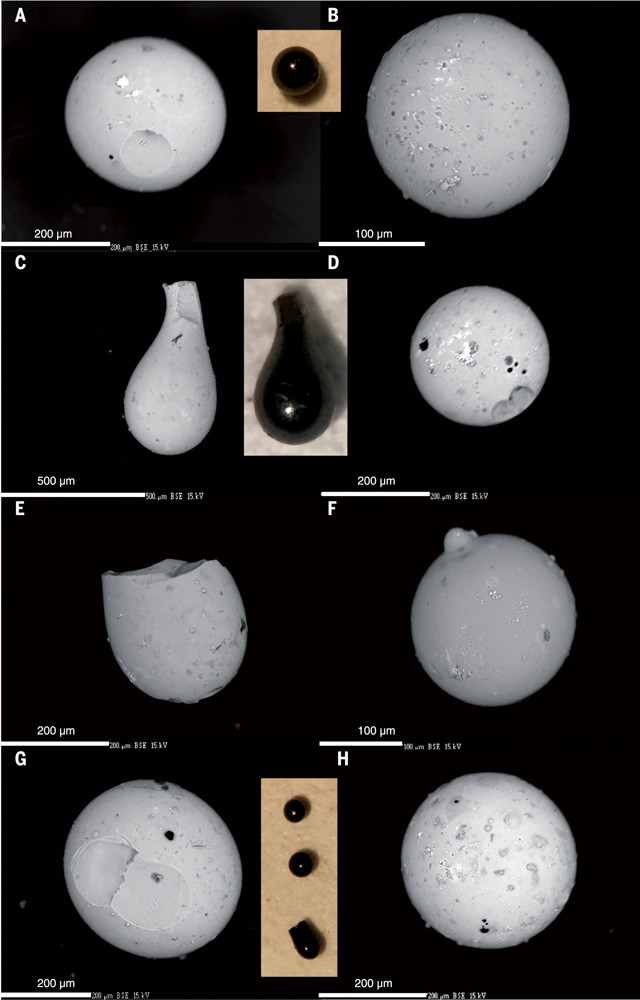
by Mary Caperton Morton Wednesday, January 25, 2017

Glassy spherules, found in 56-million-year-old clay layers along the New Jersey coast and near Bermuda, offer evidence of an impact that hit Earth at about the time of a rapid global warming event. Credit: Schaller et al., Science, October 2016.
About 56 million years ago, the planet warmed rapidly in a mysterious event known as the Paleocene-Eocene Thermal Maximum (PETM). Researchers recently discovered evidence in the rock record from around the same time that points to an extraterrestrial impactor striking Earth, but whether the two events are related is yet to be determined.
When large meteorites hit Earth, they do so at very high speeds, vaporizing everything in the immediate impact area. Some of this material is thrown high into the atmosphere, where it quickly turns into glass and falls back to the surface as spherical, sand-grain-sized glass droplets known as microtektites, or spherules. In the new study, published in Science, researchers reported finding microtektites in eight drill cores collected from clay layers at three locations along the coast of New Jersey and a fourth location near Bermuda.
The far-flung microtektites have a similar composition, indicating they came from the same impact event. No impact craters dating to the Paleocene-Eocene transition are known, however. Craters are hard to find; they are sometimes hidden under ocean-bottom sediments or largely erased on land by erosion, so “finding them is always serendipitous,” says Morgan Schaller, a geochemist at Rensselaer Polytechnic Institute in New York and lead author of the new study. The distribution pattern of microtektites found in the new work offers few clues to their source, he says. “You could have a small impact close by that would produce that abundance of spherules, or you could have a large impact on the other side of the globe that would give you that distribution in a distant location.”
“It’s always exciting to find a new impact ejecta layer,” says Billy Glass, an impact geologist at the University of Delaware who was not involved in the new study. Such spherules can also be formed through volcanic processes, “but these are definitely not volcanic,” he says. Their unusual composition — they’re high in calcium, for example — may indicate the impact struck rocks rich in calcium carbonate, possibly pointing toward a marine setting, he says, which may explain why no crater is known from this time period.
The timing of the impact relative to the PETM is the most exciting aspect of the new find, Schaller says. The clay layer containing the spherules dates to about 56 million years ago, right around when PETM warming was ramping up. The spherules themselves have not yet been dated, though the team is working to do so. Whether the impact could have triggered the warming is speculative so far, he says.
If it did, it may have done so by releasing carbon to the atmosphere. Geologists have thought that the PETM warming episode was triggered by a massive release of carbon either through volcanism or a sudden release of seafloor methane, or a combination of both. Whatever the cause, global temperatures rose by as much as 9 degrees Celsius. The warm period lasted about 200,000 years and led to many extinctions — as well as speciations — but how long the event took to ramp up is unclear. Some scientists think the carbon release took place over 20,000 years while others think it may have been much more rapid — possibly triggered by a catastrophe.
If the impact played a role in the release of carbon — perhaps by bringing carbon with it in the form of a carbon-rich comet, or by triggering volcanism or release of seafloor methane — it would support the idea that the PETM ramp-up was rapid, a once-controversial idea put forth in 2003 by Dennis Kent of Rutgers University, a co-author of the new study.
More evidence is needed to confirm a link between the impact and the PETM, Glass says. “The timing is certainly intriguing and there’s a possibility of a connection,” he says. “A big impact in the right setting at the right time could possibly trigger a warming event. [Schaller and his colleagues] just don’t have enough info to speculate on the cause and effect yet.”
The next step, in addition to dating the spherules found so far, will be to find more microtektites in correlative layers of clay elsewhere along the U.S. East Coast and around the world, Schaller says. “Hopefully, the size of particles and thickness of the layers [of spherules] will help us start to narrow down where the impact was and how large it might have been.”
© 2008-2021. All rights reserved. Any copying, redistribution or retransmission of any of the contents of this service without the expressed written permission of the American Geosciences Institute is expressly prohibited. Click here for all copyright requests.